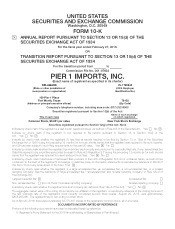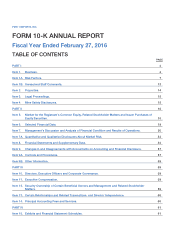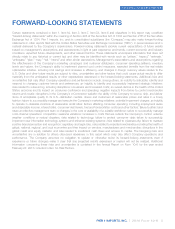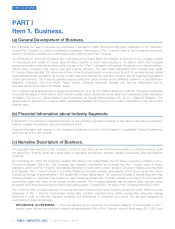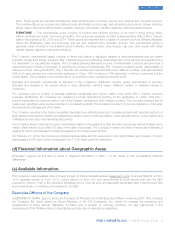Pier 1 2016 Annual Report Download - page 16
Download and view the complete annual report
Please find page 16 of the 2016 Pier 1 annual report below. You can navigate through the pages in the report by either clicking on the pages listed below, or by using the keyword search tool below to find specific information within the annual report.
ITEM 1A. RISK FACTORS.
orders, accurate shipping of undamaged product and coordination of those activities within the Company’s retail stores. In
addition, the Company’s customer service function must maintain a high standard of customer care. Failure to successfully
manage these processes may negatively impact sales, result in the loss of customers, and damage the Company’s reputation.
The Company operates in a highly competitive retail environment with companies offering
similar merchandise. If customers are lost to the Company’s competitors, sales could
decline.
The Company operates in the highly competitive specialty retail business competing with specialty sections of large general
merchandise retailers and department stores, home furnishing retailers, small specialty stores, online retailers and marketplaces,
and mass merchandising discounters. Management believes that the Company is competing for sales on the basis of style,
pricing and quality of products, constantly changing merchandise assortment, visual presentation of its merchandise and
customer service. The Company experiences added short-term competition when other retailers offer promotional pricing,
including free shipping, or liquidate merchandise for various reasons. If the Company is unable to maintain a competitive position,
it could experience negative pressure on retail prices and loss of customers, which in turn could result in reduced margins and
operating results.
The Company’s business is subject to seasonal variations, with a significant portion of its
sales and earnings occurring during two months of the year.
The Company generally has its highest sales volumes during the November and December holiday selling season. Severe
weather or failure to predict consumer demand correctly during these months could result in lost sales or gross margin erosion if
merchandise must be marked down significantly to clear inventory.
Factors that may or may not be controllable by the Company may negatively affect the
Company’s financial results.
The Company’s financial results may be negatively impacted by increases in costs that are beyond the Company’s control,
including items such as increases in fuel and transportation costs, higher interest rates, increases in losses from damaged
merchandise, inflation, litigation, fluctuations in foreign currency exchange rates, higher costs of labor, labor disputes around the
world, increases in the costs of insurance and healthcare, increases in postage and media costs, and higher tax rates. In
addition, compliance with changes in laws and regulations and compliance with accounting standards and internal control
requirements, may negatively impact the Company’s financial results.
The Company’s business may be harmed by adverse weather conditions and natural
disasters.
Extreme or undesirable weather can negatively affect customer traffic in retail stores as well as customer shopping behavior.
Natural disasters such as earthquakes, weather phenomena, and events causing infrastructure failures could negatively affect
any of the Company’s ‘1 Pier 1’ operations, including its distribution and fulfillment centers, administrative facilities, logistics
infrastructure, or operations of its suppliers domestically and in foreign countries.
Risks Associated with Dependence on Technology
The Company is heavily dependent on various kinds of technology in the operation of its
business.
Failure of any critical software applications including software-as-a-service and cloud operations, technology infrastructure,
telecommunications, data communications, data storage equipment, or networks could have a negative effect, including
additional expense, on the Company’s ability to manage the merchandise supply chain, sell merchandise, accomplish payment
functions, report financial data or manage labor and staffing. Although the Company maintains off-site data backups, a
concentration of technology-related risk exists in the Company’s headquarters located in Fort Worth, Texas.
Failure to protect the integrity and security of individually identifiable data of the Company’s
customers and associates could expose the Company to litigation and/or regulatory action
and damage the Company’s reputation.
The Company receives and maintains certain personal and payment information of its customers, vendors and associates. The
collection and use of this information by the Company is regulated at the international, national, federal and other political
subdivision levels, and is subject to certain contractual restrictions in third-party agreements. Although the Company has
10 PIER 1 IMPORTS, INC. 2016 Form 10-K



